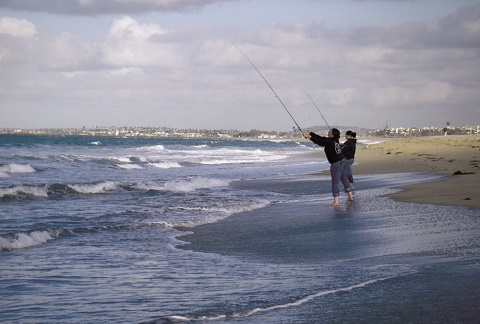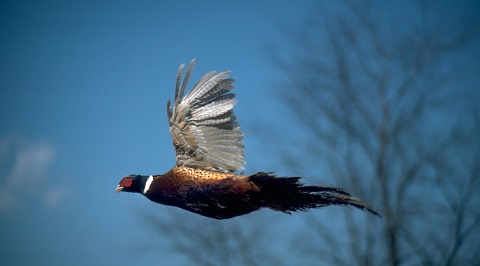Kite Fishing

by Carrie Wilson
10-29-2016
Website
Question: Can you tell me the regulations regarding using a fishing kite from shore or a pier to catch fish? We use these specially modified kites to help us get our lines out farther than the distance we could normally cast them. (Jenny C.)
Answer: There are no specific regulations prohibiting the use of a kite or other windborne device (a helium-filled balloon, for example) to help you get your line out to where the fish are. However, please be mindful of the environment and remember that any items or materials discarded or abandoned could be considered litter. If, for instance, an angler used a balloon to catch a fish and then released the balloon when the fish was hooked — or when the line reached the desired distance from shore — the angler could be subject to citation.
Also, there may be city or county ordinances that pertain to this, so please check with local authorities.
What to do about raccoons visiting my backyard
Question: I live in a residential area and raccoons have begun visiting my backyard at night. They are using my yard as a rest stop in their nightly urban foraging. Our backyard is landscaped including a grass lawn. I am looking for anything short of cages to discourage them. Is there any non-toxic substance I can spread near their entrance/exit point to discourage their visits? They do not appear to be eating or digging up anywhere in the yard, but they’ve adopted my yard as their restroom. I would appreciate any insight or suggestions you may have. (John W., Elk Grove)
Answer: We see an upsurge in raccoon sightings and reports this time of year because youngsters born in the spring are now independent of their moms and the adults are building up their fat reserves for the winter.
According to California Department of Fish and Wildlife (CDFW) Wildlife Biologist Jeff Cann, you should first remove all attractants from your yard such as pet food, dropped fruit, old garden vegetables, and securely close all garbage cans and compost heap containers. Even water can be an attractant this time of year, so if you have a fountain or fish pond, try to make it off limits (e.g. electric fence or dry it out). If the raccoons are coming in through holes in the fence, block those entry points with wire, wood or some other barrier.
Keep in mind that raccoons are excellent climbers and are capable of gaining access to yards by climbing fences or using overhanging limbs to bypass fences altogether. Cutting overhanging limbs may help to keep them from dropping in. If the raccoons are climbing over your fence, one deterrent could be to line the top with spikes or sharp tack strips. An easy way to do this is via carpet tack strips which are essentially a lot of little nails anchored in wood that carpet installers use to stretch carpet over. If you completely line the top of the fence with these then the raccoons will not use the top board as a transit way either. A “hot wire” from an electric fence charger at the top of the fence will greatly increase the effectiveness of a fence for excluding raccoons but you’ll need to find a way to properly ground it.
While these may all seem like extreme measures, the point here is to make your yard less hospitable than your neighbors so the pesky critters will move on.
If you’re looking for chemical detractors, one option you could try is Capsaicin (a chile pepper extract). It’s registered as a repellent for raccoons and may be useful in deterring trash-raiding raccoons.
A great place for more information on all of this is the University of California Integrated Pest Management Program page on raccoons. Good luck!
Is licorice legal bait?
Question: My brother and I have two burning questions we have been wondering about. Is it legal to use licorice to fish with as bait? Also, we observed a man with a syringe injecting air into his bait worms so they would float off the bottom. Is this legal? (Marcus O.)
Answer: Processed food, such as licorice, are legal under bait regulations for inland waters where bait is legal (California Code of Regulations Title 14, section 4.00). It is also legal to inject air into a fishing worm and many such kits are found at sporting goods outlets. This method can be a very effective way to keep a worm off the bottom of lakes with heavy bottom vegetation.
Can you lure a lobster with a sardine?
Question: Are you allowed to lure lobsters out of a hole with a piece of sardine in your hand? (David C.)
Answer: Sure, you can give it a try, but I don’t know how successful you’ll be. The law says that skin and SCUBA divers may take crustaceans by the use of the hands only and may not possess any hooked device while diving or attempting to dive for them (CCR Title 14, section 29.80). There is no prohibition against waving snacks in front of them.
Carrie Wilson is a marine environmental scientist with the California Department of Fish and Wildlife. While she cannot personally answer everyone’s questions, she will select a few to answer each week in this column. Please contact her at CalOutdoors@wildlife.ca.gov.
More Reports
California Department of Fish & Wildlife Reports
for Wednesday, October 26th, 2016
• Habitat Restoration Projects Help Waterfowl
• Fall Apprentice Pheasant Hunts Announced
• USFWS Allows Import of Wild LIon Trophies
• 2016 General Pheasant Hunting Opener

10-23-2016
The California Department of Fish and Wildlife (CDFW) and California Wildlife Officers Foundation are again co-sponsoring the annual “Passing on...... Read More
